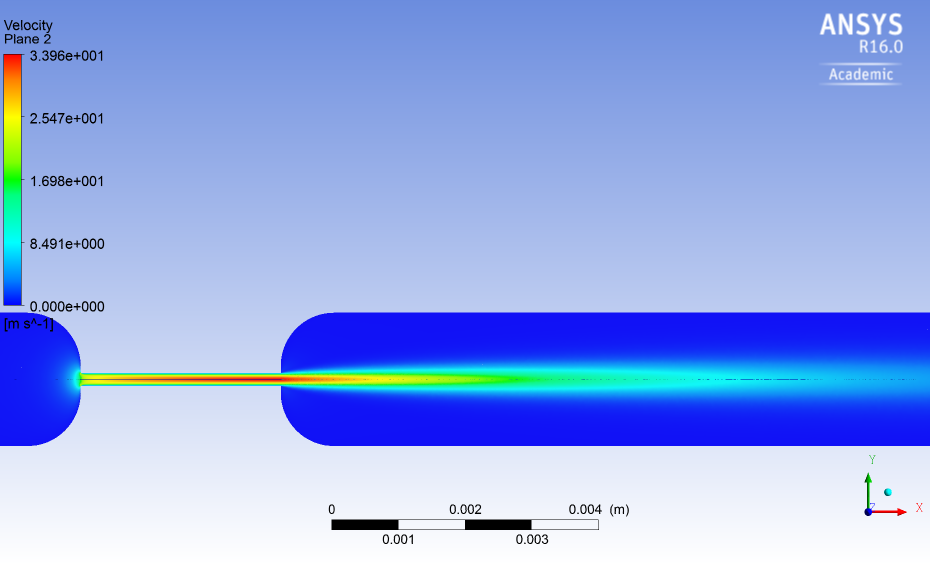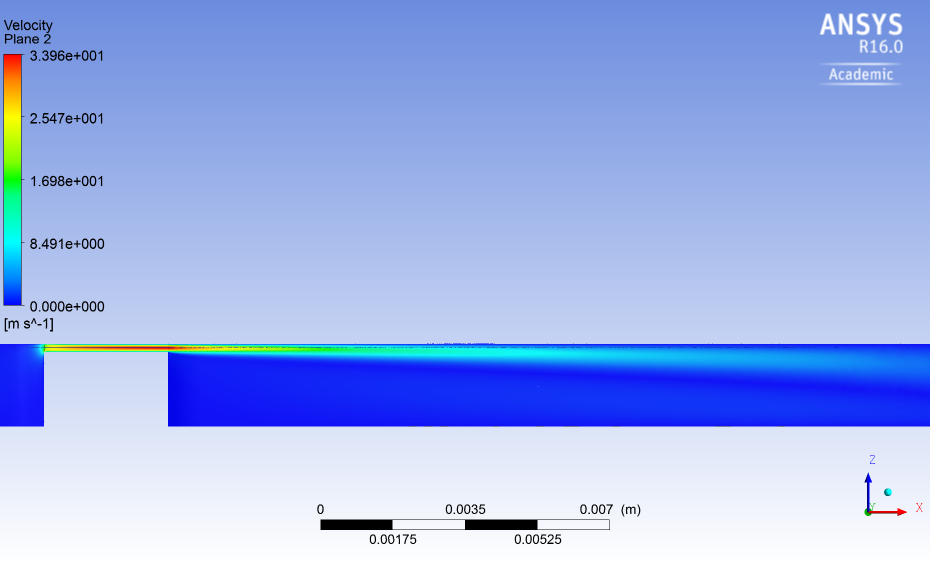 |
|
|
[Sponsors] | |||||
Choosing Turbulence Model for transitionl flows |
 |
|
|
LinkBack | Thread Tools | Search this Thread | Display Modes |
|
|
|
#1 |
|
New Member
Hannes
Join Date: Apr 2015
Posts: 3
Rep Power: 11  |
Hello guys,
I am currently working on a 3D flow simulation of an orifice for high pressure homogenization for my thesis. The orifice is part of a 2D2C µPIV (Particle Image Velocity) flow measurement system. Since the system cannot handle velocities above 100-150 m/s the Reynolds numbers only range from about 300-3000. This is clearly not fully turbulent. I understand that most turbulence models base on fully turbulent flows to be fully applicable. I am looking for the most accurate model for my case. So if you have any experience which model provides the best solutions please share it with me  Here are some more information: First of all I am using Fluent but since this is a question regarding turbulence models I hope it is okay to post it in the Main CFD Forum The goal of my investigation is to compare the limitations of both techniques CFD and PIV. Most CFD Users use the experimental results of PIV measurements to validate their simulations but I would like to do it both ways. The 2D2C µPIV measurement produces errors due to particles moving out of the 2D measurement plane. The movement in z-direction produces errors since PIV measurement compares two images and calculates the speed of the particles due to the change of position. Since my simulation should give an idea of this error it must be as accurate as it can be. There are 3D3C measurement techniques such as stereo PIV but it is not applicable (and affordable) to our problem. At the moment I am thinking about a 4 equ Transition SST or 7 equ Reynolds Stress model. Thank you for your input!!!! Hannes Last but not least some images of my orifice (results of a laminar calculation Re=230) First picture: View of the orifice from above (diameter of the canal = 0,2mm)   Second picture: Side view the orifice is build like this to be able to visualize the flow in the canal. The orifice is made from steel with acrylic glas on top to be accessible for the laser and camera Second picture: Side view the orifice is build like this to be able to visualize the flow in the canal. The orifice is made from steel with acrylic glas on top to be accessible for the laser and camera
|
|
|
|

|
|
|
|
|
#2 |
|
Senior Member
Filippo Maria Denaro
Join Date: Jul 2010
Posts: 6,775
Rep Power: 71    |
My opinion is that for your goal the only correct approach would be DNS...any turbulence modelling is by itself a source of errors therefore the comparison will be not really meaningful
|
|
|
|

|
|
|
|
|
#3 |
|
New Member
Hannes
Join Date: Apr 2015
Posts: 3
Rep Power: 11  |
Unfortunally fluent does not support DNS.
The question is: Does anyone have the experience to predict which turbulence model would suit best for my case with transitional flow (Re 300-3000), a rather simple geometry (see pictures) and pressure inlet and outlet. I know that there is no such thing as an exact model and I will have to be very careful with my results and their interpretation. |
|
|
|

|
|
|
|
|
#4 |
|
New Member
Join Date: Sep 2012
Posts: 11
Rep Power: 13  |
This is not correct. DNS are nothing a CFD code needs to "support". Simply choose to do a laminar flow without a turbulence model and resolve your grid down to the Kolmogorov scale. What indeed is a problem is that you probably won't have enough computational power to finish your run in a reasonable amount of time.
|
|
|
|

|
|
|
|
|
#5 | |
|
Senior Member
Filippo Maria Denaro
Join Date: Jul 2010
Posts: 6,775
Rep Power: 71    |
Quote:
Fluent does support, DNS, it is simply the laminar model! You must use secondo order scheme and an a fine grid, nothing else...  Or you can try LES |
||
|
|

|
||
|
|
|
#6 |
|
New Member
Hui Zhu
Join Date: May 2015
Posts: 4
Rep Power: 10  |
Hi,
I believe the only way for FLUENT to simulate a transitional jet flow is the transitional SST model. DNS may be conceptually correct, but unfortunately the numerical dissipation in FLUENT code will fail you. Remember typical LES (such as Smagorinsky model) can never simulate transition from laminar to turbulence, since the sub-grid stress model is designed for a fully turbulent flow. |
|
|
|

|
|
|
|
|
#7 | |
|
Senior Member
Filippo Maria Denaro
Join Date: Jul 2010
Posts: 6,775
Rep Power: 71    |
Quote:
FLuent can be used in DNS switching to second order central discretization instead of upwinding. However, the grid should be very fine. Furthermore, LES with dynamic Smagorinsky model could be used to simulate transitional flows, however some past experience with LES implemented in Fluent showed to take some care in the analysis of the results |
||
|
|

|
||
|
|
|
#8 | |
|
New Member
Hui Zhu
Join Date: May 2015
Posts: 4
Rep Power: 10  |
Quote:
|
||
|
|

|
||
|
|
|
#9 |
|
Senior Member
Filippo Maria Denaro
Join Date: Jul 2010
Posts: 6,775
Rep Power: 71    |
||
|
|

|
|
|
|
|
#10 |
|
Senior Member
|
Be aware that when the 'transitional' label is attached to a RANS like model it usually means that it has a sort of 'smart' switcher to predict the trsndition location for, say, attached flows over wings. They clearly cannot work on overall transitional flows. Still, the results with some low Re RANS model will not be that bad if the dimulation converges. I confirm everything said by FMDenaro on Fluent and DNS/LES. You can do both, the schemes snd the models are there. My experience with a similar flow (Re=22000 at the orifice of a lab scale burner) says that LES with Fluent is achievable and trustable for such case. Still, you need to set it up properly.
|
|
|
|

|
|
|
|
|
#11 |
|
New Member
Hannes
Join Date: Apr 2015
Posts: 3
Rep Power: 11  |
Thank you all for your input!
I will measure and simulate 5-8 different flows. I will keep you updated on my results. If anyone has more experince or ideas to share: you are more than welcome!!! 
|
|
|
|

|
|
 |
| Tags |
| orifice, piv, tranisitional flow, turbunce model |
|
|
 Similar Threads
Similar Threads
|
||||
| Thread | Thread Starter | Forum | Replies | Last Post |
| Modified k-e turbulence model UDF | Travis | Fluent UDF and Scheme Programming | 7 | November 11, 2018 20:21 |
| An error has occurred in cfx5solve: | volo87 | CFX | 5 | June 14, 2013 17:44 |
| K - epsilon VS SST turbulence model | Maicol | Main CFD Forum | 0 | November 30, 2012 16:25 |
| What model of turbulence choose to study an external aerodynamics case | raffale | OpenFOAM | 0 | August 23, 2012 05:45 |
| Turbulence model for vortical flows | Dan Chambers | STAR-CCM+ | 0 | December 30, 2010 09:07 |